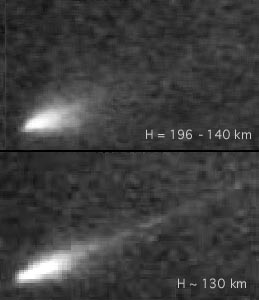|
Leonid MAC |
| home |
| View the shower |
| Mission Brief |
| Science Update |
| Media Brief |
| links |
LEONID DAILY NEWS: November 4, 2000
Images of a bright Leonid meteor above and below 136 km altitude.
The high altitude image has no tail, but a V-shaped wake.
FEAR OF HEIGHTS?
If you are used to jumping off the low board at your swimming pool, you know how it feels
to stand on the high board. That sensation struck astronomers Pavel Spurny of
Ondrejov Observatory and Hans Betlem of the Dutch Meteor Society when they analysed
the bright fireballs photographed during the 1998 Leonid campaign. The Leonids were
filmed with intensified video cameras at the time of the famous fireball shower
from two locations near Beijing, China,
where Spurny and Betlem provided ground-based support for the 1998 Leonid MAC mission.
Triangulation of the video records turned up amazingly high beginning points of the
luminous trajectory. Leonids showed up first at an altitude of 196 km!
That is twice the typical ablation height of meteors...
More carefull inspection of the meteors showed that all were distinctly "fuzzy" in
appearance, looking more like a small comet than the usual tear drop.
When these meteoroids reach 135-130 km height, the diffuse structure of the radiation quickly transforms to the usual droplet shape, and a
meteor train starts to develop. Only at that time, meteors are picked up by the
tradiational technique of all-sky photography.
This is just the latest new
fashion statement for meteors that is at odds with standard ablation theory. High altitude luminosity of meteors is of astrobiology interest because the meteoroids are not
heated much by the air collisions and only very volatile (read organic) compounds are
thought to be lost by evaporation. However, luminosity at 196 km altitude may well ask for a
totally different mechanism!
This result was published in a recent issue of Meteoritics and Planetary Science, the
journal of the American Meteoritical Society (Full paper - PDF).
It is not clear what is responsible for the meteor emission above 130 km.
The air is extremely thin and
very few air collisions must be capable of generating a lot of light.
The fan of light in the meteor images
suggests an excitation mechanism that is capable of spreading into the
ambient air with speeds
up to 40 km/s. The Russian
astronomer Andrei Ol'khovatov of the Radio Instrument Scientific Research Institute in Moscow
has proposed that ion beam plasma instabilities are responsible, whereby electrons
heated by the plasma waves interact with the ambient atmosphere to cause the luminosity
(AIAA Paper 2000 - 0589, html).
This mechanism was proposed before to explain luminosity observed during re-entry of space
vehicles, but has since been discarded in favor of other causes.
Will this mechanism stand up to the scruteny of new data and models?
Nov. 04 - Fear of heights? Nov. 03 - The pale (infra-red) dot Nov. 02 - Twin showers Nov. 01 - Leonids approaching Earth Oct. 31 - Prospects for Moon Impact Studies Oct. 30 - Comet dust crumbled less fine
| ||


